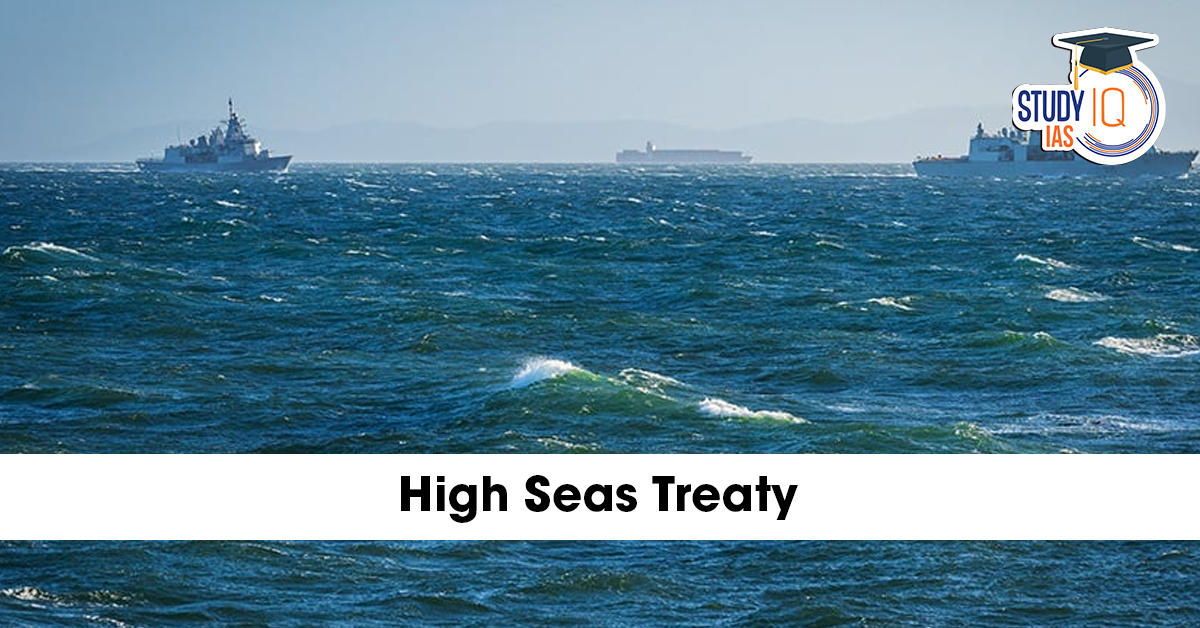Table of Contents
The High Seas Treaty—formally known as the Biodiversity Beyond National Jurisdiction (BBNJ) Agreement—will come into force in January 2026.
While hailed as a landmark in marine conservation, its implementation faces major hurdles, including funding disputes, governance ambiguities, and lack of participation by major powers like the United States, China, and Russia.
Background
The High Seas Treaty was ratified by over 60 countries in September 2025, marking the most significant development in global ocean governance since the United Nations Convention on the Law of the Sea (UNCLOS, 1982).
It aims to:
-
Conserve marine biodiversity in areas beyond national jurisdiction (ABNJ),
-
Promote sustainable use of ocean resources,
-
Address overfishing, pollution, and climate change, and
-
Ensure equitable benefit-sharing of Marine Genetic Resources (MGRs).
These “high seas” constitute nearly two-thirds of the world’s oceans, making them critical to climate regulation, carbon sequestration, and global food security.
Understanding the High Seas Treaty
The BBNJ Agreement introduces a comprehensive legal and scientific framework for managing global oceans. It focuses on four main pillars:
1. Marine Genetic Resources (MGRs)
-
MGRs include genetic material from marine organisms—plants, animals, and microbes—used in pharmaceuticals, biotechnology, and agriculture.
-
The treaty recognises these as the “Common Heritage of Humankind.”
-
It mandates monetary and non-monetary benefit-sharing between developed and developing nations to ensure fairness.
2. Area-Based Management Tools (ABMTs)
-
Establishes Marine Protected Areas (MPAs) to safeguard biodiversity hotspots.
-
MPAs will be identified using scientific research and traditional knowledge.
-
Aims to create a global network of protected zones, similar to the Paris Agreement’s climate goals, but for oceans.
3. Environmental Impact Assessments (EIAs)
-
Any activity likely to impact marine environments (e.g., mining, fishing, deep-sea exploration) must undergo a mandatory EIA.
-
Ensures preventive action before ecological harm occurs, promoting the “precautionary principle.”
4. Capacity Building and Technology Transfer
-
Addresses the technological divide between developed and developing nations.
-
Promotes access to research tools, data sharing, and marine technology, ensuring inclusive participation in ocean governance.
Evolution of the Treaty
| Year | Event |
|---|---|
| 2004 | UNGA establishes Ad Hoc Working Group to address gaps in UNCLOS. |
| 2011 | Agreement on four key areas – MGRs, ABMTs, EIAs, and Capacity Building. |
| 2018–2023 | Four Intergovernmental Conferences held to finalize negotiations. |
| March 2023 | Final agreement reached among member states. |
| June 2023 | Treaty formally adopted. |
| September 2025 | Ratified by 60+ countries. |
| January 2026 | Treaty to enter into force. |
Major Challenges in Implementation
Despite its global significance, the High Seas Treaty faces multiple operational, political, and legal challenges:
1. Ambiguity Between “Common Heritage” and “Freedom of the Seas”
Two conflicting principles underlie the treaty:
-
Common Heritage of Humankind: Ocean resources belong to all and must be shared equitably.
-
Freedom of the High Seas: All states have unrestricted rights to navigate, fish, and explore.
The treaty tries to balance these, but legal ambiguities persist.
For instance, while MGRs are under “common heritage,” enforcement remains weak, leaving scope for unequal benefit-sharing and corporate exploitation.
2. Governance of Marine Genetic Resources
Before the treaty, no global law regulated bioprospecting—the extraction of genetic material from the deep sea.
Developed countries and corporations often patented such discoveries without compensating source regions—raising concerns of “biopiracy.”
Although the BBNJ treaty calls for benefit-sharing mechanisms, it lacks:
-
Clear criteria for valuation of MGRs,
-
Transparent systems for distribution of benefits, and
-
Guidelines for intellectual property rights (IPR) management.
3. Limited Participation from Major Powers
The absence of maritime superpowers like the USA, China, and Russia poses a serious challenge.
Without their ratification, the treaty’s enforcement capacity and global legitimacy remain incomplete.
These nations control a significant portion of high seas activities, including deep-sea mining, shipping, and fishing, making their cooperation indispensable.
4. Coordination with Existing Institutions
The BBNJ must work in tandem with existing frameworks such as:
-
International Seabed Authority (ISA)
-
Regional Fisheries Management Organizations (RFMOs)
-
International Maritime Organization (IMO)
Without clear boundaries, there is a risk of jurisdictional overlap and fragmented governance.
For example, the ISA regulates seabed mining, while BBNJ covers biodiversity—potentially leading to conflicting mandates.
5. Implementation and Monitoring Mechanisms
-
The treaty requires robust monitoring, verification, and reporting systems, which are currently underdeveloped.
-
Developing nations lack financial and technical resources to monitor MPAs or conduct scientific assessments.
-
Without real-time data sharing and transparency, compliance may remain inconsistent.
Other Key Concerns
-
Funding Mechanisms: Disputes over who will finance conservation efforts and capacity building.
-
Data Sovereignty: Questions over ownership of marine data collected during research.
-
Enforcement: Lack of penalties for non-compliance and weak dispute resolution mechanisms.
Way Forward
To ensure the success of the High Seas Treaty, the following steps are crucial:
1. Finalize Operational Guidelines
Develop detailed rules for:
-
Benefit-sharing
-
EIA standards
-
Monitoring and reporting protocols
2. Encourage Universal Ratification
Diplomatic efforts should focus on engaging major maritime powers to join the treaty for global legitimacy.
3. Strengthen Institutional Cooperation
Create synergy between BBNJ, ISA, IMO, and UN Environment Programme (UNEP) to avoid duplication and strengthen accountability.
4. Enhance Technology Transfer
Developed nations must commit to sharing technology and expertise for marine exploration and conservation with developing nations.
5. Integrate Ocean and Climate Governance
Link the treaty’s implementation with frameworks like:
-
Paris Climate Agreement (2015)
-
Kunming-Montreal Global Biodiversity Framework (2022)
This will promote a holistic approach to global sustainability.
Conclusion
The High Seas Treaty (BBNJ Agreement) is a historic step toward equitable and sustainable ocean governance.
It reflects a growing global realization that the ocean’s health is central to humanity’s future.
However, the treaty’s success will depend on:
-
Strong political will,
-
Cooperation among major powers, and
-
Effective enforcement and capacity-building mechanisms.
If implemented sincerely, the High Seas Treaty can bridge the gap between conservation and development, ushering in a new era of global marine stewardship.


 Industrial Parks in India: Driving Manuf...
Industrial Parks in India: Driving Manuf...
 National Maritime Heritage Complex (NMHC...
National Maritime Heritage Complex (NMHC...
 Reforming Fertiliser Subsidy in India: N...
Reforming Fertiliser Subsidy in India: N...

























